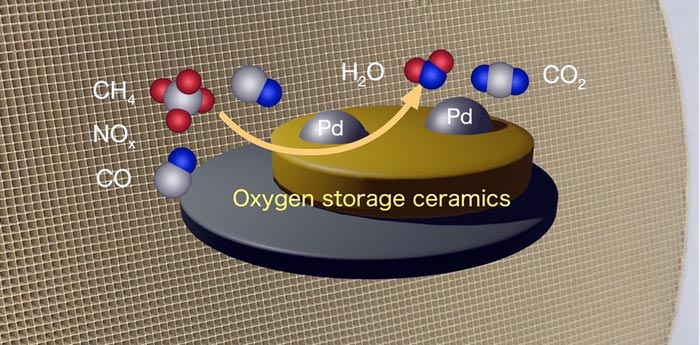Ceramics that breathe oxygen at lower temperatures

Oxygen storage ceramics in an exhaust gas system.
Credit: Hitoshi Takamura
… help us breathe cleaner air.
Although much of the discourse on reducing vehicle emissions centres on electric vehicles (EV), their sales remain low – with EV vehicles accounting for a mere 1% of car purchases in Japan in 2021. Meanwhile, the European Union is expected to pass stricter emission standards in the near future. This makes improving the performance and functionality of exhaust gas purification catalysts in petrol or diesel-powered vehicles a critical component in the push towards carbon neutrality.
Nearly all petrol or diesel cars are equipped with catalytic converters that remove harmful hydrocarbons, carbon monoxide and nitrogen oxide and convert them into safer gases such as nitrogen, carbon dioxide and water vapor. The toxic gases flow through a honeycomb structure, coated with exhaust gas purifying catalysts.
Ceramics with an oxygen storage capacity (OSC) play a crucial role in the purification process. They help remove noxious gases and prevent the precious metals in catalytic converters from coarsening, which degrades their purification capabilities.
To improve their potential, however, a lower operating temperature is required. But scientists have struggled to achieve this since reducing the temperature to less than 500 ºC results in slower ion diffusion.
Now, a research group at Tohoku University’s Graduate School of Engineering has developed a Cerium-Zirconium-based (Ce-Zr) oxide with excellent OSC at 400 ºC by controlling its crystal structure. The OSC at 400 ºC was higher than conventional materials by a factor of 13.5, even without precious metal catalysts.
“The key to our success was introducing a tiny amount of transition metals, such as iron, to the Ce-Zr-based oxides,” said Professor Hitoshi Takamura, leader of the research group.
The ‘transition metal doping’ had two notable effects in the oxides. It accelerated the oxygen diffusion by easing the formation of oxygen vacancies and promoted cation ordering.
“Cation ordering tidies up the crystal structure and makes oxygen readily released,” explained Takamura.
The iron doping reduced the cation-ordering temperature, which in turn enabled a larger surface area for the Ce-Zr-based oxides. This enhanced their durability and ability to purify toxic gases.
In the future, Takamura and his group hope to test the material by loading it with palladium on honeycomb supports.
Details of the group’s research were published in the Journal of Materials Chemistry A on September 27, 2022. And the article was chosen for the front cover of the journal.
Journal: Journal of Materials Chemistry A
DOI: 10.1039/d2ta05068d
Article Title: The low-temperature synthesis of cation-ordered Ce-Zr-based oxide via an intermediate phase between Ce and Fe
Article Publication Date: 27-Sep-2022
Media Contact
Public Relations
Tohoku University
public_relations@grp.tohoku.ac.jp
riginal Source
http://www.tohoku.ac.jp/en/press/ceramics_that_breathe_oxygen_lower_temperature.html
All latest news from the category: Materials Sciences
Materials management deals with the research, development, manufacturing and processing of raw and industrial materials. Key aspects here are biological and medical issues, which play an increasingly important role in this field.
innovations-report offers in-depth articles related to the development and application of materials and the structure and properties of new materials.
Newest articles
Faster, more energy-efficient way to manufacture an industrially important chemical
Zirconium combined with silicon nitride enhances the conversion of propane — present in natural gas — needed to create in-demand plastic, polypropylene. Polypropylene is a common type of plastic found…

Energy planning in Ghana as a role model for the world
Improving the resilience of energy systems in the Global South. What criteria should we use to better plan for resilient energy systems? How do socio-economic, technical and climate change related…

Artificial blood vessels could improve heart bypass outcomes
Artificial blood vessels could improve heart bypass outcomes. 3D-printed blood vessels, which closely mimic the properties of human veins, could transform the treatment of cardiovascular diseases. Strong, flexible, gel-like tubes…





















